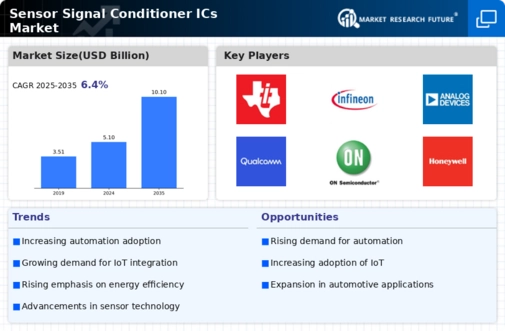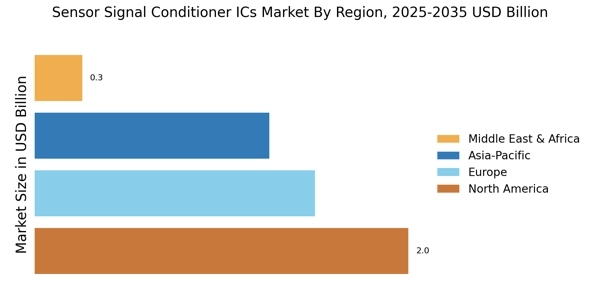Rising Demand for Automation
The increasing demand for automation across various industries appears to be a primary driver for the Sensor Signal Conditioner ICs Market. As industries strive for enhanced efficiency and productivity, the need for precise sensor data becomes paramount. Automation systems rely heavily on accurate signal conditioning to ensure that sensors provide reliable data for decision-making processes. This trend is particularly evident in manufacturing, where the integration of advanced robotics and automated systems necessitates high-performance signal conditioning solutions. According to recent estimates, the automation sector is projected to grow at a compound annual growth rate of over 10%, further propelling the demand for sensor signal conditioners. Consequently, this growth trajectory indicates a robust market potential for sensor signal conditioner ICs.
Growth in Consumer Electronics
The burgeoning consumer electronics sector is emerging as a significant driver for the Sensor Signal Conditioner ICs Market. With the proliferation of smart devices, including smartphones, wearables, and home automation systems, the demand for high-quality sensor data is escalating. These devices often incorporate multiple sensors that require precise signal conditioning to function optimally. Market analysis suggests that the consumer electronics industry is set to witness a growth rate of around 6% annually, which will likely translate into increased demand for sensor signal conditioners. As manufacturers strive to enhance user experience through improved sensor performance, the role of signal conditioning ICs becomes increasingly vital, thereby bolstering market prospects.
Emergence of Smart Infrastructure
The emergence of smart infrastructure initiatives is poised to act as a catalyst for the Sensor Signal Conditioner ICs Market. As cities and organizations invest in smart technologies to improve efficiency and sustainability, the integration of advanced sensors becomes essential. These sensors require effective signal conditioning to ensure accurate data transmission and processing. The smart infrastructure market is projected to grow at a rate of approximately 9% annually, driven by investments in smart grids, transportation systems, and environmental monitoring. This trend indicates a growing reliance on sensor technologies, which in turn is likely to boost the demand for signal conditioner ICs, positioning the market for substantial growth in the coming years.
Advancements in Sensor Technologies
Technological advancements in sensor technologies are likely to significantly influence the Sensor Signal Conditioner ICs Market. As sensors become more sophisticated, the need for effective signal conditioning solutions that can handle complex data outputs is becoming increasingly critical. Innovations in sensor types, such as MEMS and optical sensors, require specialized signal conditioning to ensure accurate data interpretation. The market for these advanced sensors is expected to expand, with projections indicating a growth rate of approximately 8% annually. This growth in sensor technology not only enhances the performance of various applications but also drives the demand for compatible signal conditioning ICs, thereby creating a favorable environment for market expansion.
Regulatory Standards and Compliance
The implementation of stringent regulatory standards across various industries is influencing the Sensor Signal Conditioner ICs Market. Compliance with safety and performance standards necessitates the use of reliable signal conditioning solutions to ensure that sensor data meets required specifications. Industries such as automotive and healthcare are particularly affected, as they must adhere to rigorous regulations regarding data accuracy and reliability. This regulatory landscape is expected to drive the adoption of high-quality signal conditioner ICs, as companies seek to mitigate risks associated with non-compliance. The increasing focus on safety and quality assurance is likely to create a sustained demand for advanced signal conditioning technologies, thereby enhancing market growth.
















Leave a Comment